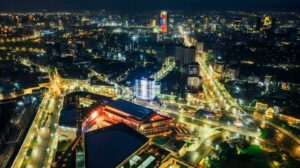Askhab Mausoleums of Merv

The Askhab Mausoleums are a Timurid-era shrine in Merv dedicated to two of the Prophet Muhammad’s earliest companions, Hazrat Abu Buraidah al-Aslami and the 2nd one is of Hazrat Abu Dhar al-Ghifari (historical legend), among the earliest converts to Islam.
Taking the form of two side-by-side iwans (monumental portals), the monuments were likely first built in the Seljuq era (9th-12th centuries) but were subsequently destroyed in the Mongol invasions of the early 13th century. The Timurids rebuilt them in the 15th or 16th centuries.
Iwans were often used by the Timurids as the entrances to monumental buildings such as mosques or madrasas, but here they serve instead as free-standing backdrops to the two small mausolea that stand in front of them.
Early photographs from the 1890s show that the monuments were in extreme state of disrepair with none of the original tile work surviving apart from the inner surfaces of the iwans, which were somewhat protected from the elements. The iwans were substantially restored from 1992 onward which stabilized their structural condition.

The conservators paid particular attention to preserving the remaining tile work, which takes the form of intersecting geometric patterns that frame various square Kufic inscriptions such as the word “Allah” at the center of a rub el hizb (eight-sided Islamic star).
Three colors predominate: a dark cobalt blue, a lighter turquoise, and the backdrop of tan-colored baked brick. The conservationists were able to match the color of the original tiles precisely, such that it is difficult to tell old and new tiles apart without close inspection.
Set in front of the iwans are two small tomb chambers housing the cenotaphs of the askhabs (the companions of Muhammad). As the crucible of Islam in southwest Arabia lies over 2,500 kilometers from Merv, it is unlikely, to say the least, that the two askhabs were originally buried here.
More likely, the monuments were intended as sites of ritual commemoration in the manner of the nearby Mohammed ibn Zayed memorial, and were later conflated with the original burial sites which no longer exist.
Apart from the tombs and the iwans, a small sardoba also stands nearby. In past generations it was used as a source of cool, clean water, and indeed, water may still be found in its sheltered interior. However, due to careless visitors who have polluted it with trash, it is likely no longer suitable for drinking without remediation.

